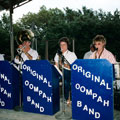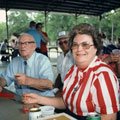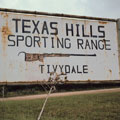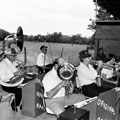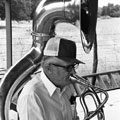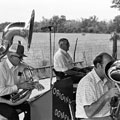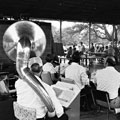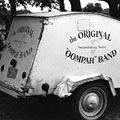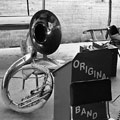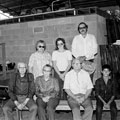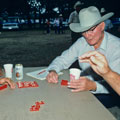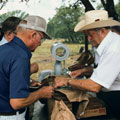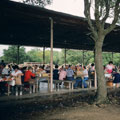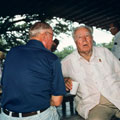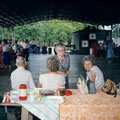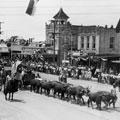Original Oompah Band
German dance music band from Tivydale, Texas
Media
Milton H. Wendel answers the question "What's the purpose of the reunion?" Interview with Alan Govenar. Recorded by Alan Govenar. Tivydale, Texas, 1986.
James Hartmann answers the question "Are you still fluent in German?" Interview with Alan Govenar. Recorded by Alan Govenar. Tivydale, Texas, 1986.
James Hartmann answers the question "What type of music do you play in your band now?" Interview with Alan Govenar. Recorded by Alan Govenar. Tivydale, Texas, 1986.
James Hartmann tells the story of Hugo Usner. Interview with Alan Govenar. Recorded by Alan Govenar. Tivydale, Texas, 1986.
James Hartmann answers the question "How did you get started playing German music?" Phone interview with Alan Govenar, 2010.
James Hartmann talks about his great-grandfather passing down his sheet music. Phone interview with Alan Govenar, 2010.
James Hartmann talks about growing up with German as his first language. Phone interview with Alan Govenar, 2010.
James Hartmann talks about his time playing in German bands. Phone interview with Alan Govenar, 2010.
Dianne Pehl talks about the musical culture of her childhood. Phone interview with Alan Govenar, 2010.
Dianne Pehl answers the question "What was it like playing with musicians 50 years older than you?" Phone interview with Alan Govenar, 2010.
Dianne Pehl answers the question "Did the Original Oompah Band rehearse?" Phone interview with Alan Govenar, 2010.
FOR THE TEACHER
Introduction
German immigration to Texas began in 1831, when Frederick Ernst acquired land in Austin County near Industry and attracted others to move into the region over the next decade. Within a couple of years his neighbors included other German families, such as the Klebergs. The largest immigration of Germans was in the 1840s when the Adelsverein (The Society for the Protection of German Immigrants in Texas) organized at Biebrich on the Rhine near Mainz to aid thousands of people who were interested in moving to Central Texas, where they established such settlements as New Braunfels and Fredericksburg. Many German settlers in Central Texas farmed and hauled freight to and from San Antonio with ox-drawn wagons or teams of horses and mules until the coming of the railroad in 1913. As early as 1905, descendants of German settlers as well as some older settlers started a teamsters’ reunion to honor the hard work of a generation of Germans in Texas. By the 1980s, few people spoke German, sang in German choirs, or played in German brass bands that had been very popular as late as the 1960s. When James Hartmann tried to revive the brass band tradition in Fredericksburg, he faced many challenges, such as finding enough musicians to perform and identifying people who spoke German. Students can use this story to differentiate between living traditions and cultural revivals.
Objectives
Students may:
- Improve listening skills and note taking
- Discover 19th-century German immigration to Texas
- Consider the revival of fading or lost traditions
- Compare their family reunions and community celebrations with the Old Teamsters Reunion and Labor Day Oompah Band performance and dance
Big Ideas
Traditions and Revivals
- Not all traditions last.
- Sometimes when traditions fade, people become interested in reviving them.
- Reviving a tradition raises complex issues, such as authenticity, point of view, and teaching strategies
- When a community is deeply involved with a tradition, it incorporates changes that help keep it alive.
Language and Culture
- Language influences culture.
- When people lose fluency in a language, traditions tied to the language may be lost or change dramatically.
- Language connects people to the home of origin as well as to one another.
- Language is essential to song.
Immigration
- Immigration can influence a community or region long after the first settlers arrive.
- If students are not from the Hill Country, they may be unaware of the significant numbers of Germans who immigrated to Texas in the 19th century.
- Immigration contributes to diversity.
Materials
Original Oompah Band’s story and photos
Radio
clip
Everyday Music Field Notes
Traditions Venn Diagram
Time Required
1-2 class periods
Subjects
Texas history, social studies, English language arts, music
Preparation
Review the Original Oompah Band’s story and the media clip. Choose Big Ideas that you find relevant to your curriculum and your students. Copy the Everyday Music Field Notes and other worksheets students will be using and cue audio clip.
Class Discussion
Students may read the story and listen to the audio story independently, in groups, or as a class. Using the Everyday Music Field Notes worksheet will help them focus more closely. In a class discussion, raise some of the Big Ideas above, depending upon your curriculum and students’ needs and grade level. Here are questions to spark discussion:
- What languages are spoken in your home? In your community?
- Have you been to a reunion? If so, what activities took place? What kinds of food, music, and games were involved? Did people give speeches?
- Where do people dance in your community?
- How many brass instruments can you name?
- Where did Germans settle in Texas in the 19th century?
Suggested Activities
Students may work independently or collaboratively to:
Research 19th-century German immigration to Central Texas. Map the areas of German settlement in the Hill Country. Include illustrations.
Use a Venn diagram to compare a reunion that you have experienced with the description of the Old Teamsters’ Reunion in the story and the audio clip. Share results with classmates.
Investigate the brass instruments of the Oompah Band for a class report or Web page. Include illustrations and audio.
Research the occupation of teamster, which was vital to German settlers of the Hill Country. Share findings in an illustrated essay.
Assessment Strategies
Discussions
Field
notes
Maps
Venn
diagrams
Reports
Web
pages
Essays
Vocabulary
accordion
bandstand
blacksmith
brass
band
dance
band
dialect
euphonium
freight
hauling
German
immigration
mentor
oompah
band
polka
railroad
reunion
revival
saxophone
schottische
Sousaphone
teamster
trumpet
two-step
waltz
Standards
Analyze information
Use and create primary sources
Diversity
Coming
of the railroads
Resources
Websites
Watriss, Wendy, Fred Baldwin, and Lawrence Goodwyn. Coming to Terms: The German Hill Country of Texas. College Station, TX: Texas A&M University Press, 1991.
Greene, Victor. A Passion for Polka. Berkeley: University of California Press, 1992.
Recordings
Various Artists. Texas-Czech, Bohemian-Moravian Bands. Arhoolie 7026. Order from www.Arhoolie.com.
